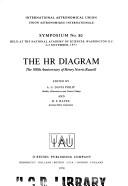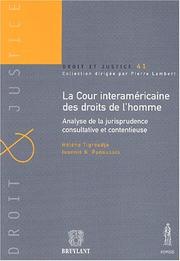| Listing 1 - 10 of 16 | << page >> |
Sort by
|
Book
Year: 2006 Publisher: Bruxelles: UCL,
Abstract | Keywords | Export | Availability | Bookmark
 Loading...
Loading...Choose an application
- Reference Manager
- EndNote
- RefWorks (Direct export to RefWorks)
Les groupes sanguins érythrocytaires représentent des antigènes présents à la surface des globules rouges. Leur transmission est génétique. Ils sont reconnus par des anticorps spécifiques. La détection de ces antigènes et des anticorps correspondants détermine les règles de comptabilité transfusionnelle et le suivi immuno hématologique de la femme enceinte.
Le premier système de groupe sanguin découvert, le système ABO, le fut en 1900 par Karl Landsteiner. Il s’agit d’un groupe tissulaire. Vinrent ensuite les systèmes MNS et P1. D’autres antigènes seront ensuite découverts au fil du temps. Actuellement, on compte environ 2700 antigènes érythrocytaires regroupés en 29 systèmes.
La majorité des antigènes de groupes sanguins sont synthétisés par la cellule érythroïde. D’autres sont absorbés à la surface des hématies à partir du plasma : c’est le cas des systèmes Le et CH/RG.
L’antigène P est bien développé à la naissance. Il sert de récepteur à certaines bactéries comme E Coli.
Il faut tenir compte du polymorphisme des groupes sanguins érythrocytaires et du risque d’alloimmunisation humaine dans la transfusion, la grossesse et, pour certains d’entre eux, la transplantation. Le formation d’auto anticorps contre ces antigènes spécifiques entraîne parfois des anémies hémolytiques auto-immunes.
Le système Rh est d’une importance capitale en transfusion ou pendant la grossesse. C’est la première cause d’immunisation par transfusion ou par grossesse.
L’immunogénicité liée à ce système est très importante. Selon l’âge et le statut immunitaire, certains sujets Rh- développent des anticorps anti-Rh dans les 6 moins après transfusion avec du sang Rh+. Il est donc nécessaire avant toute transfusion de faire un typage du groupe Rh.
Exceptionnellement, transfuser des sujets Rh- avec du sang Rh+ peut se faire, mais uniquement, pour des hommes ou des femmes qui ne sont plus en âge de procréer : par exemple en cas de manque de sang Rh- ou transfusion massive à des personnes âgées. Dans ce cas une Recherche d’Anticorps Irréguliers (RAI) devra être faite avant et dans les 6 mois suivant la tranfusion.
L’allo immunisation peut aussi survenir en cas d’incompatibilité fœto-maternelle. Il peut s’en suive une maladie hémolytique du nouveau-né lors de grossesse ultérieures (MHNN). Il faut éviter l’immunisation de femmes en âge de procréer en les transfusant toujours avec du sang iso-phénotypé (Rh et Kell)

ISBN: 341602351X 9783416023511 Year: 1991 Volume: 47 Publisher: Bonn: Bouvier,
Abstract | Keywords | Export | Availability | Bookmark
 Loading...
Loading...Choose an application
- Reference Manager
- EndNote
- RefWorks (Direct export to RefWorks)

ISBN: 2868030637 9782868030634 Year: 1994 Volume: 63 Publisher: Paris: Collège de France,
Abstract | Keywords | Export | Availability | Bookmark
 Loading...
Loading...Choose an application
- Reference Manager
- EndNote
- RefWorks (Direct export to RefWorks)
Tantras --- Commentaries --- Early works to 1800 --- Tantras. --- Yoginīhr̥dayam --- Yoginīhr̥daya --- Heart of the Yoginī --- Early works to 1800.
Book
Year: 2016 Publisher: Bruxelles: UCL. Faculté de pharmacie et des sciences biomédicales,
Abstract | Keywords | Export | Availability | Bookmark
 Loading...
Loading...Choose an application
- Reference Manager
- EndNote
- RefWorks (Direct export to RefWorks)
Sickle cell disease is a haemoglobin disorder which spread from malarious areas to become the most frequent genetic disease in Europe. A mutation of the beta globin gene leads to the synthesis of haemoglobin S which polymerizes in intracellular crystalline fibers when it’s deoxygenated: stiff sickle-shaped red blood cells are involved in haemolytic anemia and vaso-occlusive crisis observed in sickle cell disease. Thanks to current management of this disease, such as Hydrea® which increased protective fetal haemoglobin level and painkillers, life expectancy has increase from 5 years to adulthood confronting medical professionals to a new challenge: the follow-up of high risk pregnancies. Indeed, pregnancy increases the risk of drepanocytic complications and conversely, sickle cell disease increases the risk of obstetrics complications such as pre-eclampsia and eclampsia which are also risk factors for fetomaternal hemorrhage. These bleedings correspond to a passage of fetal blood into maternal circulation. Besides immediate fetal anaemia in case of massive hemorrhage, the main risk in case of rhesus incompatibility is fetomaternal allo-immunization which can lead to the hemolytic disease of the fetus and newborn. However this immunization can be prevented by the administration of a sufficient dosis of Rhogam®. In Europe and United-States prophylactic Rhogam® is administered at the end of the pregnancy sometimes followed by a second dosis after delivery, but one to three women on 1000 will still product antibodies because the prevention intervened too late or because dosis was not sufficient. Furthermore, some countries in the world don’t practice this prophylaxy: a test allowing the diagnosis and the quantification of these bleedings is thus necessary to give an appropriate dose of Rhogam® as fast as possible. Nowadays the gold standard is the Kleihauer-Betke test, but it is unusable of the pregnant women suffers from sickle cell disease: indeed this test relies on the highlighting of fetal haemoglobin but women with sickle cell disease have a high level of fetal haemoglobin, thus another test allowing to make the difference between fetal and maternal red blood cells is necessary. Flow cytometry, by immunostaining of antigen D present on the surface of red blood cells, is a more adapted alternative but is difficult to implement in routine because of its cost and logistic constraints. Other immunofluorescence techniques such as fluorescence microscopy or the extended used o fa haematology analyser, if this analyser features a flow cytometer type measurement system, seem to be the best alternatives. Indeed they combine the speed and the sensibility of the Kleihauer-Betke test with the accuracy and the specificity of flow cytometry, but they are less expensive and more usable in routine than flow cytometry. La drépanocytose est une hémoglobinopathie qui s’est étendue depuis les régions impaludées pour devenir la maladie génétique la plus fréquente en Europe. Une mutation du gène codant la chaîne beta de l’hémoglobine entraine la synthèse d’une hémoglobine S qui polymérise en fibres cristallines intracellulaires lorsqu’elle est désoxygénée : les drépanocytes rigides et peu déformables sont responsables de l’anémie hémolytique et des phénomènes de vaso-occlusion observés dans la drépanocytose. La prise en charge thérapeutique actuelle, reposant sur l’Hydrea® qui augmente le taux d’hémoglobine fœtale pour prévenir la polymérisation de l’hémoglobine S et sur le traitement symptomatique de la douleur, a permis d’augmenter l’espérance de vie des patients de 5 ans à l’âge adulte confrontant le personnel soignant à un nouveau défi : assurer le suivi médical de grossesses à haut risque. En effet, la grossesse augmente le risque de complications drépanocytaires et inversement, la drépanocytose augmente le risque de complications obstétriques telles que la pré-éclampsie ou l’éclampsie or ces complications obstétriques sont également des facteurs de risque favorisant la survenue d’hémorragies foeto-maternelles. Outre l’anémie fœtale pouvant survenir immédiatement si la quantité de sang fœtale perdue est importante, le principal risque en cas d’incompatibilité de rhésus entre la mère et l’enfant est une alloimmunistaion maternelle pouvant conduire à la maladie hémolytique du fœtus et du nouveau-né. Cette alloimmunisation peut toutefois être prévenue par l’administration d’une dose suffisante de Rhogam®. En Europe et aux Etats-Unis cette prophylaxie est administrée à la fin de la grossesse, suivie éventuellement d’une seconde dose après l’accouchement toutefois on estime qu’une à trois femmes sur 1000 s’immuniseront tout de même soit parce que la prophylaxie est intervenue trop tard, soit parce la dose administrée n’était pas suffisante. De plus tous les payse du monde ne pratiquent pas cette prophylaxie, d’où la nécessité de pouvoir diagnostiquer et quantifier ces hémorragies afin d’administrer une dose appropriée de Rhogam® le plus rapidement possible. Actuellement le test de référence est le test de Kleihaueur-Betke, mais il est inutilisable chez les femmes drépanocytaires car il repose sur la mise en évidence de l’hémoglobine fœtale, or ces femmes présentent un taux élevé d’hémoglobine fœtale : un autre test permettant de faire la différence entre des globules rouges fœtaux et maternels est donc nécessaire. La cytométrie en flux, grâce au marquage par immunofluorescence des antigènes D présents sur les hématies fœtales, est une alternative plus adaptée mais difficile à mettre en œuvre en routine en raison de son coût et de ses contraintes logistiques. D’autres méthodes d’immunofluorescence comme la microscopie à fluorescence ou l’extension de l’utilisation de l’analyseur cellulaire déjà présent au laboratoire d’hématologie, pour peu qu’il dispose d’un mode « cytomètre de flux », semblant être de meilleurs alternatives, car elles combinent la rapidité et la sensibilité du test de Kleihauer-Betke à l’exactitude et à la spécificité de la cytométrie en flux, en étant moins coûteuse et utilisable en routine.
Anemia, Sickle Cell --- Rh Isoimmunization --- Fetomaternal Transfusion --- RH-HR Blood-Group System
Book
ISBN: 9789033493270 9033493276 Year: 2013 Publisher: Leuven: Acco,
Abstract | Keywords | Export | Availability | Bookmark
 Loading...
Loading...Choose an application
- Reference Manager
- EndNote
- RefWorks (Direct export to RefWorks)
1. Comment mener un casting - 2. Appel à casting - 3.Cherchez la star - 4. Les nominations aux Oscars
Sélection du personnel Personeelsselectie --- Recrutement Werving --- Competentiemanagement --- Personeelsselectie --- Personnel management --- Handbooks, manuals, etc. --- Recrutering van personeel --- Platforms RIZIV : HR-platform --- HRM : Werving --- Plateformes INAMI : Plateforme RH --- GRH : Recrutement

ISBN: 902770905X 9027709068 9789027709066 Year: 1978 Volume: 80 Publisher: DORDRECHT: Reidel,
Abstract | Keywords | Export | Availability | Bookmark
 Loading...
Loading...Choose an application
- Reference Manager
- EndNote
- RefWorks (Direct export to RefWorks)
Galaxies --- 52 <063> --- HR diagrams --- -Stars --- -Sidereal system --- Circumstellar matter --- H-R diagrams --- Hertzsprung-Russell diagrams --- Russell diagrams --- Stars --- Astronomie. Astrofysica. Ruimteonderzoek. Geodesie--Congressen --- Congresses --- Russell, Henry Norris --- Congresses. --- Russell, Henry Norris, --- -Astronomie. Astrofysica. Ruimteonderzoek. Geodesie--Congressen --- -Congresses
Book
ISBN: 9780273713067 027371306X 9780273728634 0273728636 Year: 2009 Publisher: Harlow (England): Financial Times/Prentice Hall,
Abstract | Keywords | Export | Availability | Bookmark
 Loading...
Loading...Choose an application
- Reference Manager
- EndNote
- RefWorks (Direct export to RefWorks)
Adopting an accessible & practical perspective on the disciplines, this book focuses on the core responsibilities of people management which every manager will have to undertake & understand.
Personnel management --- Supervision of employees --- Study and teaching --- Study and teaching. --- personeelsmanagement --- supervisie van werknemers --- invloed HR op succes van het bedrijf --- diversiteit --- Personnel management - Study and teaching --- Supervision of employees - Study and teaching --- Personnel management - Great Britain --- Supervision of employees - Great Britain
Book
ISBN: 387157211X 9783871572111 Year: 2005 Volume: 2004/2005 *4 Publisher: Berlin: Deutscher Verlag für Kunstwissenschaft,
Abstract | Keywords | Export | Availability | Bookmark
 Loading...
Loading...Choose an application
- Reference Manager
- EndNote
- RefWorks (Direct export to RefWorks)
churches [buildings] --- Dresden, Frauenkirche --- Religious architecture --- Art --- Bähr, George --- Dresden --- Frauenkirche (Dresde - Allemagne) --- Frauenkirche (Dresden - Germany) --- Frauenkirche (Dresden -Duitsland) --- Church architecture --- Bahr, George, --- Frauenkirche (Dresden, Germany) --- Dresden (Germany) --- Buildings, structures, etc. --- 726.54 --- 72.034 <43> --- 72.025.4 --- Kerken. Parochiekerken --- Architectuur van de renaissance; barok; rococo en koloniale stijl--Duitsland voor 1945 en na 1989 --- Monumentenzorg: reinigen; herstellen; restauratie; vernieuwing --- 72.025.4 Monumentenzorg: reinigen; herstellen; restauratie; vernieuwing --- 72.034 <43> Architectuur van de renaissance; barok; rococo en koloniale stijl--Duitsland voor 1945 en na 1989 --- 726.54 Kerken. Parochiekerken --- Ecclesiastical architecture --- Rood-lofts --- Christian art and symbolism --- Architecture, Gothic --- Church buildings --- Bähr, George, --- Behr, George, --- Beer, George, --- Bähr, Johann George, --- Frauen-Kirche (Dresden, Germany) --- Dresden (Germany). --- Dresden. --- Dresdner Frauenkirche --- Architecture religieuse --- Germany --- Dresden (Germany: City) --- Church architecture - Germany - Dresden --- Bahr, George, - 1666-1738 --- Dresden (Germany) - Buildings, structures, etc.

ISBN: 2802717022 9782802717027 Year: 2003 Volume: 41 Publisher: Bruxelles: Bruylant,
Abstract | Keywords | Export | Availability | Bookmark
 Loading...
Loading...Choose an application
- Reference Manager
- EndNote
- RefWorks (Direct export to RefWorks)
Droits de l'homme --- Etats-Unis --- Jurisprudence --- Mensenrechten --- Rechtspraak --- Verenigde Staten --- Human rights --- Droits de l'homme (Droit international) --- Inter-American Court of Human Rights --- Inter-American Court of Human Rights. --- Corte Interamericana de Derechos Humanos --- Organization of American States. --- Corte I.D.H. --- Corte IDH --- I-A Court H.R. --- I-A Court HR --- Cour interaméricaine des droits de l'homme --- Corte Interamericana de Direitos Humanos --- Human rights - America.

ISBN: 052153335X 9780521533355 9780521825955 9780511494055 0511062508 9780511062506 0511070969 9780511070969 0511179200 9780511179204 051149405X 0521825954 1280431148 9781280431142 6610431140 9786610431144 0521825954 1107137810 0511203128 0511306253 9781107137813 9780511203121 9780511306259 Year: 2003 Publisher: Cambridge, UK New York, NY Cambridge University Press
Abstract | Keywords | Export | Availability | Bookmark
 Loading...
Loading...Choose an application
- Reference Manager
- EndNote
- RefWorks (Direct export to RefWorks)
Jo M. Pasqualucci provides a comprehensive critique of the Inter-American Court of Human Rights, which is at once scholarly yet practical. She analyzes all aspects of the Court's advisory jurisdiction, contentious jurisdiction, and provisional measures orders. When relevant, she compares the practice and procedure of the Inter-American Court with that of the European Court of Human Rights, the International Court of Justice, and the United Nations Human Rights Committee. She also evaluates the Rules of Procedure of the Inter-American Court and the Inter-American Commission, which entered into force in May and June of 2001 and bring about important procedural changes in the inter-relationship of those organs. In addition, she cites the effectiveness of the Convention and the Court's rulings in the domestic law of the States Parties to the Convention. This book will provide an important resource for scholars, practitioners, and students of international human rights law and practice.
International courts --- Human rights --- Rules and practice --- Inter-American Court of Human Rights --- mensenrechten --- Inter-American Court of Human Rights [San José] --- America --- International tribunals --- Tribunals, International --- Corte Interamericana de Derechos Humanos --- Organization of American States. --- Corte I.D.H. --- Corte IDH --- I-A Court H.R. --- I-A Court HR --- Cour interaméricaine des droits de l'homme --- Corte Interamericana de Direitos Humanos --- Rules and practice. --- Courts --- Jurisdiction (International law) --- International courts - Rules and practice --- Human rights - America --- Law --- General and Others
| Listing 1 - 10 of 16 | << page >> |
Sort by
|

 Search
Search Feedback
Feedback About UniCat
About UniCat  Help
Help News
News